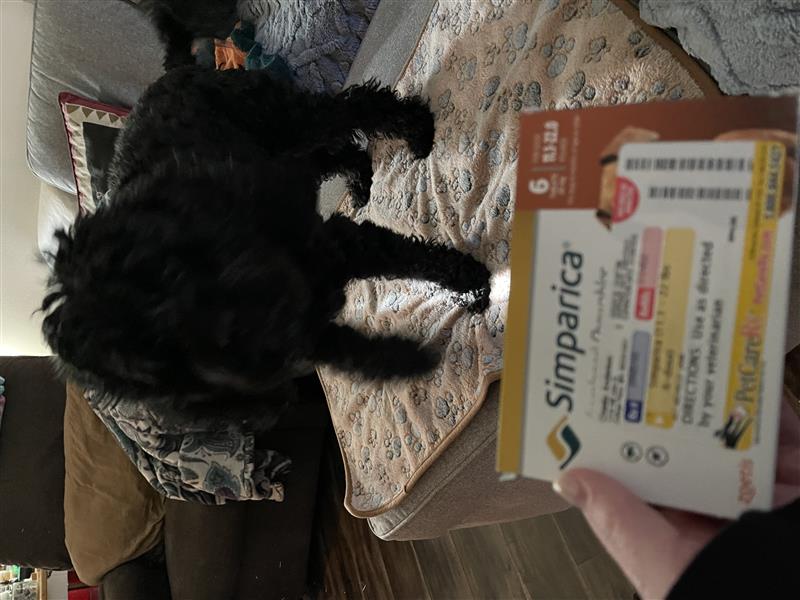What is Simparica?
Simparica is a fast-acting oral flea and tick preventative that begins killing fleas and ticks within hours of administration and remains effective for one month to prevent re-infestations. It is indicated for the treatment and prevention of flea infestations (Ctenocephalides felis), and the treatment and control of tick infestations [Amblyomma americanum (Lone Star tick), Amblyomma maculatum (Gulf Coast tick), Dermacentor variabilis (American dog tick), Ixodes scapularis (deer tick/black-legged tick), and Rhipicephalus sanguineus (brown dog tick)]. Simparica begins to kill adult fleas within 3 hours and ticks within 8 hours of administration. Treatment with Simparica may begin at any time of the year and is safe to use year-round without interruption. Simparica is given monthly and requires a prescription from your veterinarian.
Suitable For:
Dogs (6+ months of age, weighing 2.8+ lbs)
Benefits:
- Each tablet provides a full month of protection against fleas and ticks
- Tasty, liver-flavored chewable tablet is easy to administer
- Chewable tablets can be given directly to your dog or broken up and mixed with food
- Available in six weight categories: 2.8-5.5 lbs, 5.6-11 lbs, 11.1-22.0 lbs, 22.1-40 lbs, 44.1-88.0 lbs and 88.1-132 lbs
How does Simparica work?
Simparica contains the active ingredient sarolaner, which inhibits the function of the neurotransmitter gamma aminobutyric acid (GABA) receptor and glutamate receptor, and works at the neuromuscular junction in insects. This results in uncontrolled neuromuscular activity leading to death in insects or acarines. Simparica is administered once a month directly by mouth or can be crumbled and mixed with food. To minimize the likelihood of flea re-infestation, it is important to treat all dogs and cats within a household with an approved flea control product.
Cautions:
IMPORTANT SAFETY INFORMATION: Simparica is for use only in dogs 6 months of age and older. Simparica, which contains sarolaner, a member of the isoxazoline class, may cause neurologic signs such as tremors, unsteadiness and/or seizures in dogs with or without a history of neurologic disorders. Simparica has not been evaluated in pregnant, breeding, or lactating dogs. The most common adverse reactions in clinical trials were vomiting and diarrhea.
Brand Name
Simparica (Zoetis)
Generic Name
Sarolaner (sar-oh-lan-ur)
What is the most important thing I should know about Simparica?
Simparica is used for the treatment and prevention of flea infestations (Ctenocephalides felis), and the treatment and control of tick infestations [Amblyomma americanum (Lone Star tick), Amblyomma maculatum (Gulf Coast tick), Dermacentor variabilis (American dog tick), Ixodes scapularis (deer tick/black-legged tick), and Rhipicephalus sanguineus (brown dog tick)] in dogs over 6 months of age weighing 2.8 lbs and over. Simparica is available as a liver-flavored, chewable tablet. Simparica requires a prescription from your veterinarian.
What should I discuss with my veterinarian before giving Simparica to my pet?
Tell your veterinarian if your pet is breeding, pregnant, or lactating.
How Simparica should be given?
Simparica should be administered orally, once every month, at the minimum dosage of 0.91 mg/lb (2 mg/kg) sarolaner. Dogs weighing 2.8 to 5.5 lbs should be given one 5 mg Simparica chewable tablet monthly. Dogs weighing 5.6 to 11.0 lbs should be given one 10 mg Simparica chewable tablet monthly. Dogs weighing 11.1 to 22.0 lbs should be given one 20 mg Simparica chewable tablet monthly. Dogs weighing 22.1 to 44.0 lbs should be given one 40 mg Simparica chewable tablet monthly. Dogs weighing 44.1 to 88.0 lbs should be given one 80 mg Simparica chewable tablet monthly. Dogs weighing 88.1 to 132.0 lbs should be given one 120 mg Simparica chewable tablet monthly. Dogs weighing more than 132.0 lbs should be given appropriate combination of Simparica tablets monthly. Care should be taken that your dog consumes the complete dose, and treated pets should be observed for a few minutes to ensure that part of the dose is not lost or refused.
For flea treatment and prevention: Treatment may begin at any time of the year. In areas where fleas are common year-round, monthly treatment with Simparica can continue the entire year without interruption. To minimize the likelihood of flea re-infestation, it is important to treat all dogs and cats within a household with an approved flea control product.
For tick treatment and control: Treatment with Simparica can begin at any time of the year.
What are the potential side effects of Simparica?
The most frequently reported adverse reactions were vomiting and diarrhea. Simparica may cause abnormal neurologic signs such as tremors, decreased conscious proprioception [awareness of body position and movement], ataxia [loss of full control of bodily movements], decreased or absent menace [blinking reflex], and/or seizures.
What happens if I miss giving a dose of Simparica?
If a dose is missed, administer Simparica and resume a monthly dosing schedule.
What happens if I overdose my pet on Simparica?
Contact your veterinarian immediately.
What should I avoid while giving Simparica to my pet?
Do not use Simparica in cats. Simparica should not be used in dogs less than 6 months of age. The safe use of Simparica has not been evaluated in breeding, pregnant, or lactating dogs.
What other drugs will affect Simparica?
There are no known contraindications for the use of Simparica.
 Why don't we show the price? Sometimes the manufacturers do not allow us to show our price. Don't worry; you'll be able to see the price in checkout before you decide to buy it.
Why don't we show the price? Sometimes the manufacturers do not allow us to show our price. Don't worry; you'll be able to see the price in checkout before you decide to buy it.
 Why don't we show the price? Sometimes the manufacturers do not allow us to show our price. Don't worry; you'll be able to see the price in checkout before you decide to buy it.
Why don't we show the price? Sometimes the manufacturers do not allow us to show our price. Don't worry; you'll be able to see the price in checkout before you decide to buy it.

















































